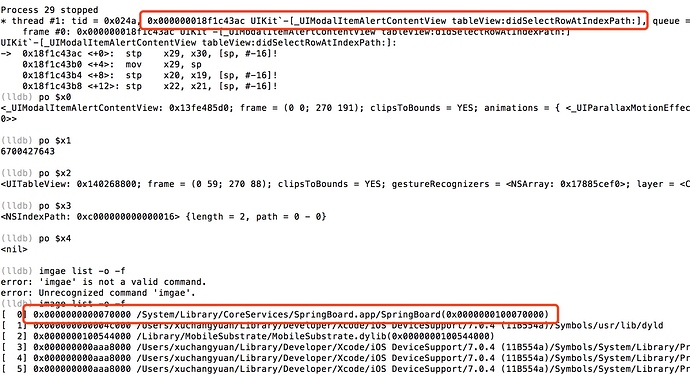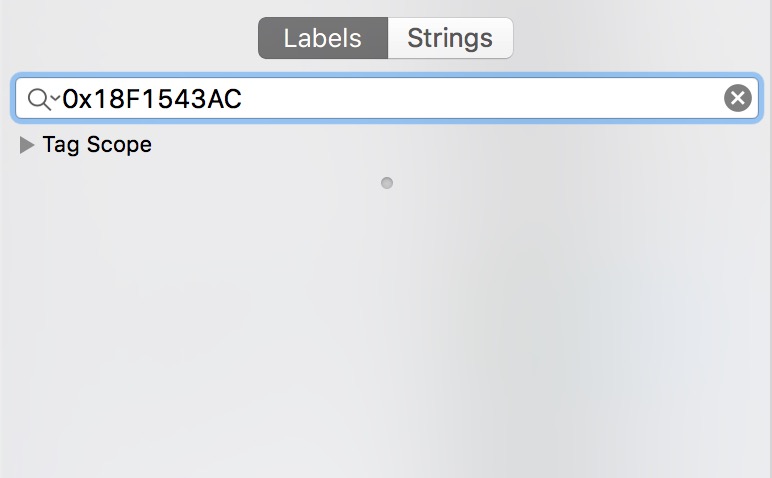recursiveDescription
I don’t think it necessary to introduce this method again. It prints the hierarchy of an UIView object. Here’s how we use it in Cycript:
cy# [[UIApp keyWindow] recursiveDescription].toString()
`<iConsoleWindow: 0x156b6410; baseClass = UIWindow; frame = (0 0; 320 480); autoresize = W+H; gestureRecognizers = <NSArray: 0x156b6bc0>; layer = <UIWindowLayer: 0x156b6720>>
| <UILayoutContainerView: 0x16258d80; frame = (0 0; 320 480); autoresize = W+H; layer = <CALayer: 0x16258e00>>
| | <UITransitionView: 0x16259610; frame = (0 0; 320 480); clipsToBounds = YES; autoresize = W+H; layer = <CALayer: 0x16259760>>
| | | <UIViewControllerWrapperView: 0x16243bb0; frame = (0 0; 320 480); autoresize = W+H; layer = <CALayer: 0x1625a670>>
| | | | <UILayoutContainerView: 0x1601dd70; frame = (0 0; 320 480); autoresize = W+H; gestureRecognizers = <NSArray: 0x16001650>; layer = <CALayer: 0x16073fe0>>
| | | | | <UINavigationTransitionView: 0x16004cc0; frame = (0 0; 320 480); clipsToBounds = YES; autoresize = W+H; layer = <CALayer: 0x16004e10>>
| | | | | | <UIViewControllerWrapperView: 0x1629d9a0; frame = (0 0; 320 480); layer = <CALayer: 0x1629da10>>
...
| | | <MMBadgeView: 0x160055a0; baseClass = UIImageView; frame = (203 1; 20 20); opaque = NO; userInteractionEnabled = NO; layer = <CALayer: 0x16005640>>
| | | | <MMUILabel: 0x16004ec0; baseClass = UILabel; frame = (0 0; 0 0); hidden = YES; userInteractionEnabled = NO; tag = 10032; layer = <CALayer: 0x16004f70>>
| | | <MMBadgeView: 0x16259810; baseClass = UIImageView; frame = (283 -4; 30 30); hidden = YES; opaque = NO; userInteractionEnabled = NO; layer = <CALayer: 0x162598b0>>
| | | | <MMUILabel: 0x1625a180; baseClass = UILabel; frame = (0 0; 0 0); userInteractionEnabled = NO; tag = 10032; layer = <CALayer: 0x1625a230>>`
_printHierarchy
Skip UIViews and nextResponders to get ViewControllers directly. Refer to this post for details.
In short, it’s:
[[[UIApp keyWindow] rootViewController] _printHierarchy].toString()
_autolayoutTrace
Simplified recursiveDescription, cuts off lots of descriptions of UIViews. Here’s how we use it in Cycript:
cy# [[UIApp keyWindow] _autolayoutTrace].toString()
*<iConsoleWindow:0x156b6410>
| *<UILayoutContainerView:0x16258d80>
| | *<UITransitionView:0x16259610>
| | | *<UIViewControllerWrapperView:0x16243bb0>
| | | | *<UILayoutContainerView:0x1601dd70>
| | | | | *<UINavigationTransitionView:0x16004cc0>
| | | | | | *<UIViewControllerWrapperView:0x1629d9a0>
...
| | | | <MMUILabel:0x1624b250>
| | | <MMBadgeView:0x160055a0>
| | | | <MMUILabel:0x16004ec0>
| | | <MMBadgeView:0x16259810>
| | | | <MMUILabel:0x1625a180>`
_ivarDescription
Prints all names and values of instance variables of a specified object. Here’s how we use it in Cycript:
cy# [choose(SBApplication)[0] _ivarDescription].toString()
`<SBApplication: 0x1766cab0>:
in SBApplication:
\t_bundleIdentifier (NSString*): @"com.apple.social.remoteui.SocialUIService"
\t_displayIdentifier (NSString*): @"com.apple.social.remoteui.SocialUIService"
\t_path (NSString*): @"/Applications/SocialUIService.app"
\t_bundleVersion (NSString*): @"87"
\t_defaultImageNamesByScreenType (NSMutableDictionary*): <__NSDictionaryM: 0x17672a90>
\t_defaultImageNamesForOrientation (NSDictionary*): nil
...
in NSObject:
\tisa (Class): SBApplication`
_methodDescription
Prints all properties, instance methods and class methods of a specified object. Here’s how we use it in Cycript:
cy# [choose(SBApplicationController)[0] _methodDescription].toString()
`<SBApplicationController: 0x17642990>:
in SBApplicationController:
\tClass Methods:
\t\t+ (void) setClearSystemAppSnapshotsWhenLoaded:(BOOL)arg1; (0x1b2ad1)
...
\t\t+ (id) sharedInstanceIfExists; (0x1b2b6d)
\tInstance Methods:
\t\t- (id) setupApplication; (0x1b3e3d)
...
\t\t- (id) applicationWithDisplayIdentifier:(id)arg1; (0x1b3d0d)
in NSObject:
\tClass Methods:
\t\t+ (bool) cy\$hasImplicitProperties; (0xdb45d80)
...
\t\t+ (void) finalize; (0x39a49ad1)
\tProperties:
\t\t@property (nonatomic) BOOL isAccessibilityElement; (@dynamic isAccessibilityElement;)
...
\t\t@property (nonatomic) BOOL shouldGroupAccessibilityChildren; (@dynamic shouldGroupAccessibilityChildren;)
\tInstance Methods:
\t\t- (id) cy\$toCYON:(bool)arg1 inSet:(set<void *, std::less<void *>, std::allocator<void *> >*)arg2; (0xdb45b60)
...
\t\t- (void) finalize; (0x39a49ad5)`
References:
- http://swiftiostutorials.com/using-private-undocumented-ios-methods-debugging/
- Shortcut to find the ViewController's class name on the keyWindow
You can edit this post following the above format.

